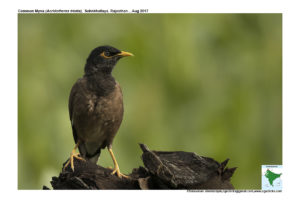
Common Myna Acridotheres tristis
Etymology:
- Acridotheres : Greek word akris- locust; theras–hunter { Locust hunter}
- Tristis : Latin word for Gloomy, sad
Vernacular Name : Hindi: Desimyna, Sans: Bharat saarika, Kash: Hor, Pun: Lalrigutar shark, M.P: Gulgul, Bemni, Saloo, Ben: Salik, Bhatsalik, Ass: Salikasorai, Salika, Ghorsalika, Cachar: Dao myna, Guj: Kabar, Kathayikabar, Mar: Shale, Salunki, Ori: Bani, Ta: For Mynas: Myna, Narthankuruvi, Te: Goranka, Mal: Kavalamkili, Kan: Gorwantera, Goravanka, Sinh: Myna, Gonkawadiya
Distribution in India: Widespread Resident in India
Description: Size of 23-25 cm. It has a glossy black head, upper parts are chestnut-brown; upper wing are brownish-black, primary coverts and bases of primaries are white ; tail is brownish-black, retrices have white tips . The chin, throat and upper breast are duller and greyer than back. The lower breast and flanks brown with vinous tinge, central belly is buff, lower belly and under tail-coverts are white; iris is brown or reddish-brown, mottled with white, bare skin behind and below eye bright yellow; bill is yellow, base of lower mandible is greenish; legs are yellow. Both the sexes are alike in plumage, male slightly larger than female.
Habitat: It is found in open country, avoiding forest; dry open woodland, floodplains, grasslands, cultivated areas, villages, towns and cities.
Food Habits: It has omnivorous, diet incorporating animal food, fruit, seeds, and food waste discarded by humans. It eats frog tadpoles, small snails, earthworms, ticks, spiders, ants and wasps and other small insects. Fruits eaten include figs, grapes, mulberries, peas and chilies. It occasional feeds on nectar. Nestlings are fed with 95% animal food, mostly insects. It forages mostly on ground; often follows the plough and accompanies cattle. Settles on cattle and removes ticks from them
Breeding Habits: They breed in Mar–Jul. Nest built by both sexes, taking up to two weeks to complete work, an untidy mass of twigs, grass and leaves, sometimes with animal hair, plastic, paper, cloth, string and other materials, placed above ground in hole or similar cavity; often in natural site such as tree hole or hole in cliff or bank, often utilizing hole made by another animal. They lay a clutch 4–5 eggs. Incubation done by both sexes, female doing more, and only female incubating at night for a period of 13–18 days. Chicks are fed by both parents, nestling period of 22–27 days; young fed by parents for several weeks after leaving nest. Nest is parasitized by Cuckoo